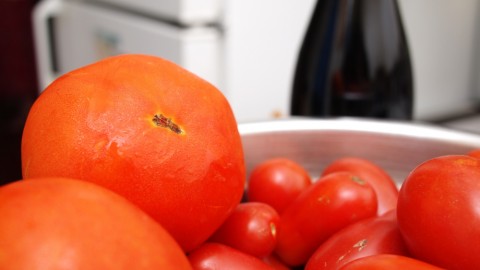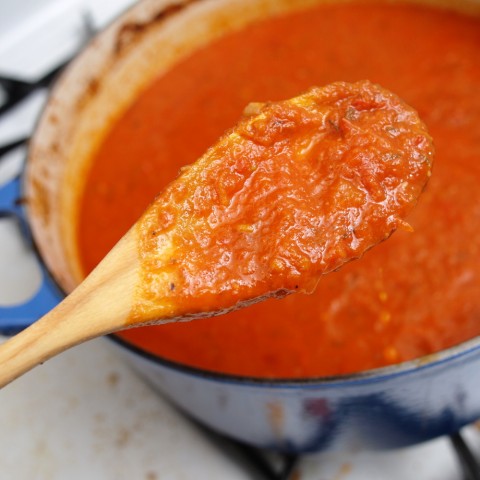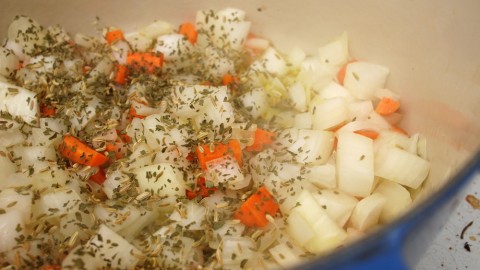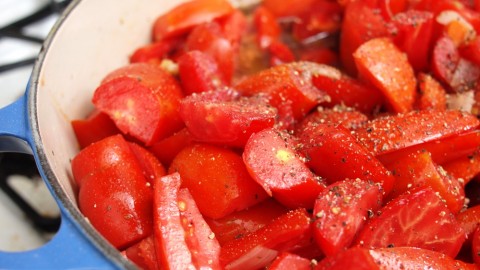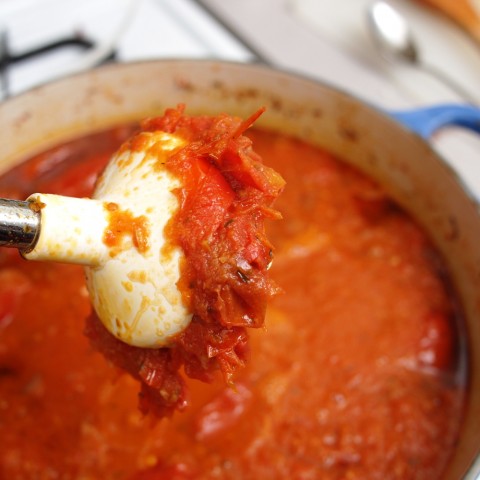I am aware, just so you know, that way back in the archives, back in my pre-historic Livejournal days, there once lived a post about tomato sauce. I am aware that embedded deep within that post is another recipe for an oven-based marinara. But I would suggest that it is possible — just possible — that I have learned something since the nascent morning of my food-blogging consciousness in 2009. I would offer the justification that this recipe is better, more mature, less demanding than the previous one. And I would say, perhaps a little laughingly, that it’s the season, not the man:
Nightshades are a thing in August. Duh! And you’ve got to cook what’s ripe.
And yet — what’s interesting to me about this recipe, and about tomato sauce in general, is that while the cooking of it is definitely an August pastime, best pursued when the tomatoes are at their reddest, the eating of it is better done in winter. If you want a summertime pasta, you want it with chunks of eggplant and zucchini. You want it with fresh herbs and a squeeze of lemon, or with a classic, refreshing pesto. Marinara is more of a November dish. It’s at its best when there is frost on the ground, and you need something hearty to reassure the body that no, we’re not going to freeze to death tonight.
Which, I suppose, is worth a bit of a laugh in itself. In order to reassure ourselves that we’re not going to freeze — the tomatoes have to. This sauce, at least in my house, is not made for immediate consumption. It is preparation for the future, for long nights when I don’t want to cook, and when it’s cruel to demand that the pizza man slog through rain, or sleet, or snow. I parcel the finished sauce out into three-cup containers, and stash it back in the back of my freezer. And the portions become ready-made packets of summer flavor, processed just so, for consumption in the cold.
This recipe, you’ll note, is gauged to use fresh tomatoes. And before we start, I’d like to offer one last comment on that. Fresh tomatoes are not those generic orbs you pick up at the supermarket. They should not have been chemically ripened, whatever that means. And there is no scenario in which they should bounce rather than bruise.
If you are going to make this recipe, use paste tomatoes that you have grown, or that come from your local farmer’s market. Make sure that they are actually ripe — as in, ripened on the vine, before they were picked. Or else, go with a reputable brand of canned tomatoes, which often have considerably more flavor than those cruel, produce-aisle jokes.
4 quarts Fresh Tomatoes, diced (San Marzanos are best, but any kind of paste tomato is okay)*
2 Medium Onions, chopped
2 Carrots, diced
1 Head of Garlic, minced
1/2 Bottle of Red Wine (anything you would drink, though I prefer something full-bodied like Rioja)
1 tbsp Balsamic Vinegar
2 Bay Leaves
2 tsp Crushed Red Pepper Flakes
1 tsp Fennel Seed
1 tsp Dried Oregano
1 tsp Dried Thyme
1 tsp Dried Parsley
Olive Oil
Granulated Sugar (if needed)
Pepper
Salt
Preheat your oven to 275F, and heat a 5-quart Dutch oven over a medium flame. When the Dutch oven is hot, add a generous helping of olive oil, along with the onion, carrot, crushed red pepper, fennel seed, and a little bit of salt, and sauté until the onions are clear. Then add the garlic, the remainder of the herbs, pepper, and a little bit more salt, and cook for another ten minutes or so, stirring occasionally.
When the aromatics have cooked, add the tomatoes and wine to the pot. Stir thoroughly, and allow everything to come to a boil. Then cover the Dutch oven, and put it in the oven for three hours.
At the end of the three hours, remove the sauce from the oven, and turn the thermostat up to 350F. Remove the bay leaves from the sauce, and use a stick blender to blend the sauce to a consistency of your choice. Assuming that you left them on when you diced the tomatoes, you’ll find that the blender picks up a lot of skins. This is good. Discard them as you go. Then season the sauce to taste with salt, pepper, and a little bit of sugar (if necessary), and return it to the oven, uncovered, for another hour.
After that hour, remove the sauce from the oven (again). Allow it to cool just a little, and divide into three-cup portions. You may, I suppose, use the portions right away. But it’s best to freeze them to use another day.
This recipe should make four generous three-cup portions.
* You may, if you wish, remove the seeds and skins from the tomatoes before you use them. But I don’t.
